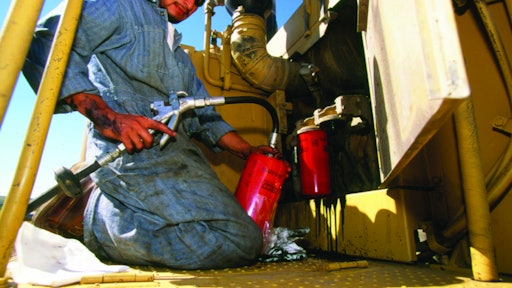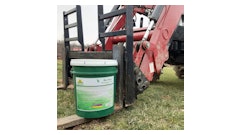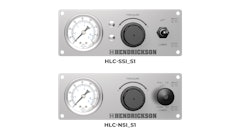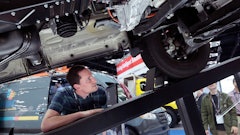
Poor maintenance practices combined with a careless operator can quickly ruin a diesel engine, resulting in an expensive overhaul. “Neglect and abuse are the largest concerns affecting our industry,” says Joe Urso, Kubota Engine America Corp. “Proper usage and maintenance, per the factory’s workshop manual, will significantly extend an engine’s life expectancy.”
It’s important for operators to understand the machine’s basic systems. “Every engine component has a specific function. Understanding how these components react with varying scenarios is critical if a [problem] surfaces,” says Urso.
It is also the operator’s job to catch minor issues before they become catastrophic failures. This requires watching for any changes in performance.
“Current and historical operating characteristics (symptoms) are vital when measuring an engine’s health,” Urso states. “For example, abnormal noises or changes in fuel or oil consumption may be early symptoms of a potential concern.”
Recognizing such symptoms, along with relevant inquiries and observations, can help to pinpoint problem areas. “Did the operating environment temperature fluctuate recently; is airflow across the radiator hindered; did the application’s workload change; are cooling system leaks visible; is the recommended fluid in use, etc.?” Urso asks. “Symptoms, either obvious or obscure, occasionally require advice from a properly trained technician to correctly diagnose and repair.”
Maintenance equals longevity
Engine life directly correlates to maintenance practices. “There are things you can do to extend life to overhaul quite a bit,” says Zack Ellison, Cummins customer technical support. Take oil selection, for example.
“The only reason oil needs to be changed is because products of combustion get down past the rings and the acids work to neutralize the total base number (TBN),” says Ellison. A 3.0 is the lowest level you want the TBN to drop.
But different oil types offer varying degrees of protection. “There is fleet-spec oil that has just barely enough additives to meet the minimum requirements, but nothing extra,” Ellison notes. Then there are higher quality oils with better additive packages. “It has more margin in it as far as TBN. It has more extreme pressure additives. A lot of times, you get what you pay for with oils.”
Of course, oil doesn’t have to be the best available to provide the needed protection. “A good oil, not a basement bottom oil, can provide just as satisfactory life to overhaul as the real expensive stuff,” says Ellison.
Maintenance program best practices can also influence engine life. Ben Hanks, senior field service representative, John Deere Power Systems, outlines the following practices to consider:
• Allow an engine to idle prior to shutting down if it has been run hard. This allows the oil and coolant to continue circulating, enabling components to cool.
• In cold conditions, allow time for the oil to warm up and circulate throughout the engine to provide lubrication.
• Perform the manufacturer’s recommended checks and inspections per the operator’s manual.
Major failure sources
A diesel engine will generally give indications that an overhaul is due. “The two main things to look for are crankcase blowby and oil consumption,” says Ellison. “Generally, as the cylinder kits wear, the rings wear; you don’t get as good of sealing against the liners.”
Oil consumption will also increase. “Oil consumption can be an indicator of engine health,” says Hanks.
A rule of thumb is 1 quart consumed for every 100 gal. of fuel. Oil consumption less than that is considered normal, while higher consumption rates should be reviewed by an authorized dealer. Oil consumption does change slightly depending upon the season (temperature) and usage (loading), so it’s important to take note of any substantial changes.
According to Ellison, the two main culprits of premature engine overhauls include a lack of cooling system maintenance and dust getting into the engine. “You really need to keep track of your supplemental coolant additives and make sure they are at the recommended level and can prevent corrosion,” he emphasizes. The trend toward aluminum places an even greater emphasis on supplemental coolant additive maintenance to prevent corrosion to these components.
The problems caused by coolant system neglect are not easy to fix. “It is a real expensive problem to resolve because you generally have to replace liners and rings,” says Ellison. “When you are in there, you generally go through the bearings and everything else. It gets pretty expensive to fix cavitation damage.”
For this reason, consider the advantages of long-life coolants with OAT (organic acid technology). “You don’t have to be as disciplined on your cooling system maintenance if you use the fully formulated coolant to do your top-off,” says Ellison. “That is the only place you can really get out of whack if you have a guy in the field that tops it off with water. You can get your chemistry out of balance.”
While coolant system neglect will eventually lead to catastrophic failure, the effects of dust are more immediate. “Customers can really be disappointed and have a big repair bill in front of them on engines that should have gone 20 times longer than they did because of dust,” says Ellison. “In less than 100 hours, dust can completely wear out a set of piston rings. Just about 6 to 8 oz. of dust is all it takes to completely destroy an engine.”
A medium-bore engine today runs at a rated speed of 1,700 or 1,800 rpms and goes through about 50 to 70 gal. of air every second. “With a turbocharger, you have a volumetric efficiency of over 100% because you boost the air,” says Ellison. “Let’s say you have an 8.3-liter engine at 1,800 rpm, so 900 times a minute, it is pulling in 8.3 liters of air at half engine speed. That is a lot of air. So a small hole or crack in a hose or tube, or a leak where the clamp seals the hose to the tubing intake system, can lead to an engine being dusted out.”
Air cleaner maintenance 101
According to Ellison, there are two practices that should never take place on your jobsite. “Sometimes operators take the air cleaner out and beat it against the tires or blow it out with an air hose. When you hit the air filter element against the tire, you are very likely to rip the filtration paper loose at the glue joints on the end plates,” he indicates. “When you blow it out with compressed air, you are likely to tear it along the pleats. All it takes is a small rip or tear and you are going to have enough dust in that engine between then and the next maintenance period to completely ruin your engine.”
View air cleaners as disposable commodities. “We do not recommend cleaning air filters,” Ellison states.
Also use a “safety filter” when possible. “I always recommend a safety cleaner — a second, smaller filter inside the primary filter,” says Ellison. “Normally, the primary filter is changed three times before you change both the primary and secondary cleaner. That way, you never entirely have the system exposed, except for every five or six primary filter changes.”
There is also a right way and a wrong way to change air filters. “There are times when people incorrectly change out and clean out their air cleaners,” says Ellison. “Cummins recommends a restriction gauge in your air system that will pop off between 20 and 25 in. of water restriction. That is when you want to change the air filter element.”
The proper way to change the element is to remove the end plate on the air filter housing and carefully pull the element out. “You go inside there with a clean wet shop towel and you get the dust and debris out of the filter housing,” says Ellison. “Then, you use a second wet towel and you clean off the sealing surfaces and the air intake where it goes into the turbocharger or into the engine. At that time, look inside the air cleaner element on the clean side and visually look for any breaches in the paper, the filtration element.”
Measuring time to overhaul
No two engines will need to be overhauled at the same time because the duty cycles are different. While engine hours can be useful to determine maintenance intervals, the number of gallons burned is a better indicator of engine life.
“That is an excellent way to determine the amount of work the engines have done,” says Ellison. “As you go up into the high horsepower markets, they generally always go by fuel consumption.” An engine that runs at 80% of full power all of the time will generally need an overhaul before one that is running in an application with a 40% duty cycle.
“Keeping accurate, up-to-date records and monitoring engine performance are effective ways to determine engine health,” adds Hanks. Routine oil and coolant sampling and analysis are also useful. “Oil samples are valuable in monitoring engine health, but indications of ‘critical’ wear could be one-time events and should be viewed with objectivity. Many parts of an engine can contribute to wear metals in the oil, so oil analysis should be considered one piece of a diagnosis puzzle used to narrow down areas of potential failure.”
Another piece of the puzzle is a compression test, which can be useful for checking the condition of the cylinders. “Anything more than about a 10% to 15% difference between cylinders indicates something is different between the sealing components in the low cylinder compared to the good cylinder,” says Ellison.
It is important to note that compression specifications can vary between engine makes and models. “When performing an engine compression test, it is important to reference the respective factory workshop manual for proper procedures, specifications and allowable limits,” says Urso. Kubota Engine America suggests compression variances between cylinders should remain under 10%.
The most recent engine control units allow simplified compression tests. “With new engine controllers, there are two options for testing compression: a relative compression test and an actual compression test,” says Hanks. “A relative compression test monitors engine speed through the sensors on the crankshaft and shows relative compression by comparing deceleration and acceleration of the crankshaft as each piston rises on the compression stroke.”
The relative test can only monitor differences between cylinders and not an actual value. “Many newer machines with engine controllers have the capability to test relative compression through a user interface such as John Deere’s Service ADVISOR,” Hanks notes. “An actual compression test measures dynamic pressure and may be performed using a gauge to determine compression of an individual cylinder. A number of manufacturers provide a minimum specification for cylinder performance.”
There are other ways to gauge cylinder health. “One thing I have found to be more useful than a pressure test is a leak-down test,” says Ellison. “You pressurize the cylinder and there is actually a gauge that will tell you what percent leakage it is. The beauty of the leak-down tester is you can actually listen for where the leakage is — whether it is going into the crankcase or coming out of an exhaust or intake valve. That helps identify what might need some attention.”
There are many tools available for inspecting the cylinder bore without disassembling the engine, including borescopes. “Usually, simple mechanical checks for blow-by and valve lash will prove just as effective as disassembling the engine,” says Hanks. “On newer machines, John Deere dealers can utilize Service ADVISOR to perform diagnostic tests that eliminate the need for many mechanical checks. Disassembling and reassembling the engine hardware is normally the last option. A typical approach is to monitor routine oil and coolant analysis.”




























